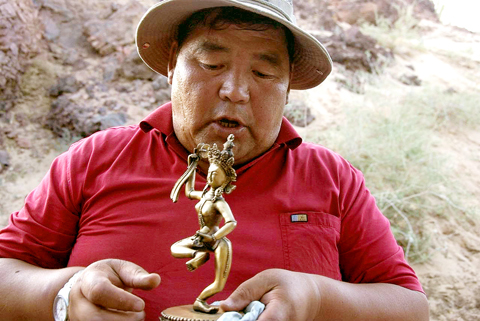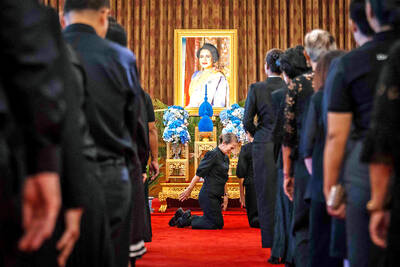Digging for buried treasure in the Gobi Desert sounds like the opening scene of an Indiana Jones film. For Austrian-born Michael Eisenriegler, it was a real-life adventure.
The 40-year-old amateur archeologist was in the Gobi over the weekend, helping to unearth Buddhist relics that had been buried for more than seven decades in a remote part of Mongolia.
Less than an hour of digging revealed two crates filled with priceless treasure, including rare manuscripts, Buddhist statues and clothing.

PHOTO: AFP
The relics were once part of a much larger cache of artwork housed at Khamaryn monastery, located 450km southeast of the capital, Ulan Bator.
The monastery was looted and destroyed by order of the communist government in 1937, but not before one monk named Tuduv hid many of the sacred objects.
Around 1,500 boxes of treasure had originally been stored at the monastery. Tuduv managed to bury 64 of them. The rest were destroyed.
Tuduv maintained the secret of the hidden crates for decades until finally revealing the story to his grandson Zundoi Altangerel.
When freedom of religion was allowed with the end of communism in 1990, Altangerel dug up a third of the boxes and placed his findings in a new museum.
Eisenriegler, an online media producer, visited the museum last year, met Altangerel and learned that many more boxes still lay hidden in the Gobi.
The museum was apparently not safe enough to house all the artifacts so Altangerel left about 20 boxes hidden in the wilderness. His grandfather had made him memorize the exact location of the crates.
Eisenriegler convinced the historian to dig up some of the boxes. That happened on Saturday with a joint team of Mongolian and Austrian experts on hand to inspect the items as they came out of the ground.
“My ancestors protected these boxes for many years. Now it is my duty to protect them,” said Altangerel after the dig. “In the future we plan to dig up the remaining crates.”
The event was filmed and streamed live on the Internet. Web users who logged on to the site, www.gobi-treasure.com, were encouraged to donate money, which will be given to Altangerel to improve his museum.
Viewers watched as the excavators spent 45 minutes digging into the earth, lifted the boxes out of the ground and displayed their contents.
The boxes housed a trove of artifacts including bronze statues, holy texts known as sutras and other riches. Altangerel carefully lifted the items out of the boxes and described their meaning.
Many were musical instruments, possibly used in Buddhist ceremonies at the monastery. He displayed a small drum that he described as a child’s toy.
The crates also contained manuscripts. Historians are interested in studying the texts, hoping they will provide clues to daily life at Khamaryn Khiid.
“We were deeply impressed with this event … These treasures were some of the most amazing things that I have seen, especially the statues,” Eisenriegler said after the dig.
The texts should also go a long way in helping historians better understand the founder of the monastery, Danzan Ravjaa, who lived from 1803 to 1856.
The legendary monk wrote hundreds of poems, performed Mongolia’s first opera and established schools and a museum. Wild legends about his miraculous feats still circulate among the Gobi nomads.
“We did this as a way to promote Danzan Ravjaa in the West,” Eisenriegler said. “He is worth being studied and known in the West. We also want Mongolians to get to know their history and Danzan Ravjaa is a big part of that.”
Danzan Ravjaa was best known for writing Mongolia’s first opera, Saran Khokhoo, or “Moon Cuckoo.” He staged the event at various monasteries across the Gobi Desert, raising money for building projects at his monastery. When Danzan Ravjaa died his mummified body was placed inside the White Temple of Khamaryn Khiid, and boxes of treasure were set around the body.
The relics remained there until the 1930s when the Mongolian army closed the monastery and arrested most of the monks, charging them with “counter-revolutionary activities.”

DOUBLE-MURDER CASE: The officer told the dispatcher he would check the locations of the callers, but instead headed to a pizzeria, remaining there for about an hour A New Jersey officer has been charged with misconduct after prosecutors said he did not quickly respond to and properly investigate reports of a shooting that turned out to be a double murder, instead allegedly stopping at an ATM and pizzeria. Franklin Township Police Sergeant Kevin Bollaro was the on-duty officer on the evening of Aug. 1, when police received 911 calls reporting gunshots and screaming in Pittstown, about 96km from Manhattan in central New Jersey, Hunterdon County Prosecutor Renee Robeson’s office said. However, rather than responding immediately, prosecutors said GPS data and surveillance video showed Bollaro drove about 3km

‘MOTHER’ OF THAILAND: In her glamorous heyday in the 1960s, former Thai queen Sirikit mingled with US presidents and superstars such as Elvis Presley The year-long funeral ceremony of former Thai queen Sirikit started yesterday, with grieving royalists set to salute the procession bringing her body to lie in state at Bangkok’s Grand Palace. Members of the royal family are venerated in Thailand, treated by many as semi-divine figures, and lavished with glowing media coverage and gold-adorned portraits hanging in public spaces and private homes nationwide. Sirikit, the mother of Thai King Vajiralongkorn and widow of the nation’s longest-reigning monarch, died late on Friday at the age of 93. Black-and-white tributes to the royal matriarch are being beamed onto towering digital advertizing billboards, on

Tens of thousands of people on Saturday took to the streets of Spain’s eastern city of Valencia to mark the first anniversary of floods that killed 229 people and to denounce the handling of the disaster. Demonstrators, many carrying photos of the victims, called on regional government head Carlos Mazon to resign over what they said was the slow response to one of Europe’s deadliest natural disasters in decades. “People are still really angry,” said Rosa Cerros, a 42-year-old government worker who took part with her husband and two young daughters. “Why weren’t people evacuated? Its incomprehensible,” she said. Mazon’s

POWER ABUSE WORRY: Some people warned that the broad language of the treaty could lead to overreach by authorities and enable the repression of government critics Countries signed their first UN treaty targeting cybercrime in Hanoi yesterday, despite opposition from an unlikely band of tech companies and rights groups warning of expanded state surveillance. The new global legal framework aims to bolster international cooperation to fight digital crimes, from child pornography to transnational cyberscams and money laundering. More than 60 countries signed the declaration, which means it would go into force once ratified by those states. UN Secretary-General Antonio Guterres described the signing as an “important milestone,” and that it was “only the beginning.” “Every day, sophisticated scams destroy families, steal migrants and drain billions of dollars from our economy...